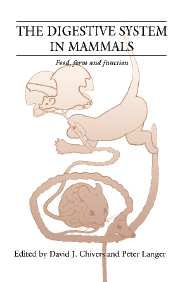Book contents
- Frontmatter
- Contents
- List of contributors
- Preface
- Part I Introduction
- 1 Gut form and function: variations and terminology
- 2 Food and digestion of Cenozoic mammals in Europe
- 3 Modelling gut function: an introduction
- 4 Optimum gut structure for specified diets
- Part II Food
- Part III Form
- Part IV Function
- Part V Synthesis and perspectives
- Index
2 - Food and digestion of Cenozoic mammals in Europe
Published online by Cambridge University Press: 18 March 2010
- Frontmatter
- Contents
- List of contributors
- Preface
- Part I Introduction
- 1 Gut form and function: variations and terminology
- 2 Food and digestion of Cenozoic mammals in Europe
- 3 Modelling gut function: an introduction
- 4 Optimum gut structure for specified diets
- Part II Food
- Part III Form
- Part IV Function
- Part V Synthesis and perspectives
- Index
Summary
Fossil European mammalian species belonging to orders that have survived to the present day can – most probably – be allocated to the same type of digestion as their extant close relatives. The general habitus can be determined from fossil remains; the habitus – as well as the dentition – represents adaptations to a certain mode of life and a certain type of digestion that is similar to conditions in a closely-related species from the Recent (Holocene). Of course, the type of digestion in an extinct taxon can only be considered as highly probable, and not as absolutely certain.
It is also probable that the type of food is similar in extinct and recent species of the same order and/or family. For example, it is plausible that a perissodactyl ingested plant material and was certainly not zoophagous. Also, it was most probably a caecumcolon fermenter, as are its present-day relatives, and did not ferment the ingested plant material in a forestomach. The above-mentioned assumptions accepted, it is possible to classify mammals from the Cenozoic era (fossil mammals) according to the food they ate and according to their type of digestion – as long as they belong to orders that still survive today!
The following questions will be covered in the present study:
What were the steps – and when were these steps undertaken – to widen the range of food that could be used by European fossil mammals?
When did major steps in the differentiation of new types of digestion take place?
What can be said about the combinations between types of food and types of digestion in European mammalian orders and families?
[…]
- Type
- Chapter
- Information
- The Digestive System in MammalsFood Form and Function, pp. 9 - 24Publisher: Cambridge University PressPrint publication year: 1994
- 7
- Cited by



